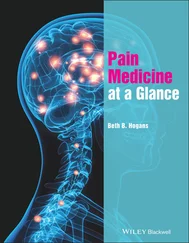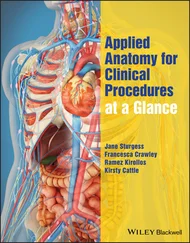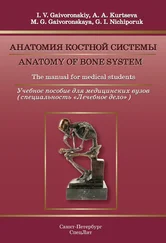Binding of drugs to receptors
Intermolecular forces
Drug molecules in the environment of receptors are attracted initially by relatively long‐range electrostatic forces. Then, if the molecule is suitably shaped to fit closely to the binding site of the receptor, hydrogen bonds and van der Waals forces briefly bind the drug to the receptor. Irreversible antagonists bind to receptors with strong covalent bonds.
This is a measure of how avidly a drug binds to its receptor. It is characterized by the equilibrium dissociation constant ( K D), which is the ratio of rate constants for the reverse ( k −1) and forward ( k +1) reactions between the drug and the receptor. The reciprocal of K Dis called the affinity constant ( K A), and (in the absence of receptor reserve, see below) is the concentration of drug that produces 50% of the maximum response.
Most antagonists are drugs that bind to receptors but do not activate them . They may be competitive or irreversible. Other types of antagonists are less common.
Competitive antagonistsbind reversibly with receptors, and the tissue response can be returned to normal by increasing the dose of agonist, because this increases the probability of agonist–receptor collisions at the expense of antagonist–receptor collisions. The ability of higher doses of agonist to overcome the effects of the antagonist results in a parallel shift of the dose–response curve to the right and is the hallmark of competitive antagonism.
Irreversible antagonistshave an effect that cannot be reversed by increasing the concentration of agonist. The only important example is phenoxybenzamine , which binds covalently with α‐adrenoceptors. The resulting insurmountable block is valuable in the management of phaeochromocytoma, a tumour that releases large amounts of epinephrine (adrenaline).
Other types of antagonism
Non‐competitive antagonistsdo not bind to the receptor site but act downstream to prevent the response to an agonist, e.g. calcium‐channel blockers ( Chapter 15).
Chemical antagonistssimply bind to the active drug and inactivate it, e.g. protamine abolishes the anticoagulant effect of heparin ( Chapter 19).
Physiological antagonistsare two agents with opposite effects that tend to cancel one another out, e.g. prostacyclin and thromboxane A2 on platelet aggregation ( Chapter 19).
In some tissues (e.g. smooth muscle), irreversible antagonists initially shift the log dose–response curve to the right without reducing the maximum response, indicating that the maximum response can be obtained without the agonist occupying all the receptors. The excess receptors are sometimes called ‘spare’ receptors, but this is a misleading term because they are of functional significance. They increase both the sensitivity and speed of a system because the concentration of drug–receptor complex (and hence the response) depends on the product of the agonist concentration and the total receptor concentration.
These are agonists that cannot elicit the same maximum response as a ‘full’ agonist. The reasons for this are unknown. One suggestion is that agonism depends on the affinity of the drug–receptor complex for a transducer molecule (lower figure). Thus, a full agonist produces a complex with high affinity for the transducer (e.g. the coupling G‐proteins, Chapter 1), whereas a partial agonist–receptor complex has a lower affinity for the transducer and so cannot elicit the full response.
When acting alone at receptors, partial agonists stimulate a physiological response, but they can antagonize the effects of a full agonist. This is because some of the receptors previously occupied by the full agonist become occupied by the partial agonist, which has a smaller effect (e.g. some β‐adrenoceptor antagonists, Chapters 15and 16).
This is the ability of an agonist to alter the conformation of a receptor in such a way that it elicits a response in the system. It is defined as the affinity of the agonist–receptor complex for a transducer.
Partial agonists and receptor reserve. A drug that is a partial agonist in a tissue with no receptor reserve may be a full agonist in a tissue possessing many ‘spare’ receptors, because its poor efficacy can be offset by activating a larger number of receptors than that required by a full agonist.
Bioassays involve the use of a biological tissue to relate drug concentration to a physiological response. Usually isolated tissues are used because it is then easier to control the drug concentration around the tissue and reflex responses are abolished. However, bioassays sometimes involve whole animals, and the same principles are used in clinical trials.
Bioassays can be used to estimate:
the concentration of a drug (largely superseded by chemical methods);
its binding constants; or
its potency relative to another drug.
Measurement of the relative potencies of a series of agonists on different tissues has been one of the main ways used to classify receptors, e.g. adrenoceptors ( Chapter 7).
Binding assays are simple and very adaptable. Membrane fragments from homogenized tissues are incubated with radiolabelled drug (usually 3H) and then recovered by filtration. After correction for non‐specific binding, the [ 3H]drug bound to the receptors can be determined and estimations made of K Aand B max(number of binding sites). Binding assays are widely used to study drug receptors, but have the disadvantage that no functional response is measured, and often the radiolabelled drug does not bind to a single class of receptor.
Localization of receptors
The distribution of receptors, e.g. in sections of the brain, can be studied using autoradiography. In humans, positron‐emitting drugs can sometimes be used to obtain images (positron emission tomography [PET] scanning) showing the location and density of receptors, e.g. dopamine receptors in the brain ( Chapter 27).
Tachyphylaxis, desensitization, tolerance and drug resistance
When a drug is given repeatedly, its effects often decrease with time. If the decrease in effect occurs quickly (minutes), it is called tachyphylaxisor desensitization. Tolerancerefers to a slower decrease in response (days or weeks). Drug resistanceis a term reserved for the loss of effect of chemotherapeutic agents, e.g. antimalarials ( Chapter 43). Tolerance may involve increased metabolism of a drug, e.g. ethanol, barbiturates ( Chapter 3), or homeostatic mechanisms (usually not understood) that gradually reduce the effect of a drug, e.g. morphine ( Chapter 29). Changes in receptors may cause desensitization, e.g. suxamethonium ( Chapter 6). A decrease in receptor number (downregulation) can lead to tolerance, e.g. insulin ( Chapter 36).
3 Drug absorption, distribution and excretion
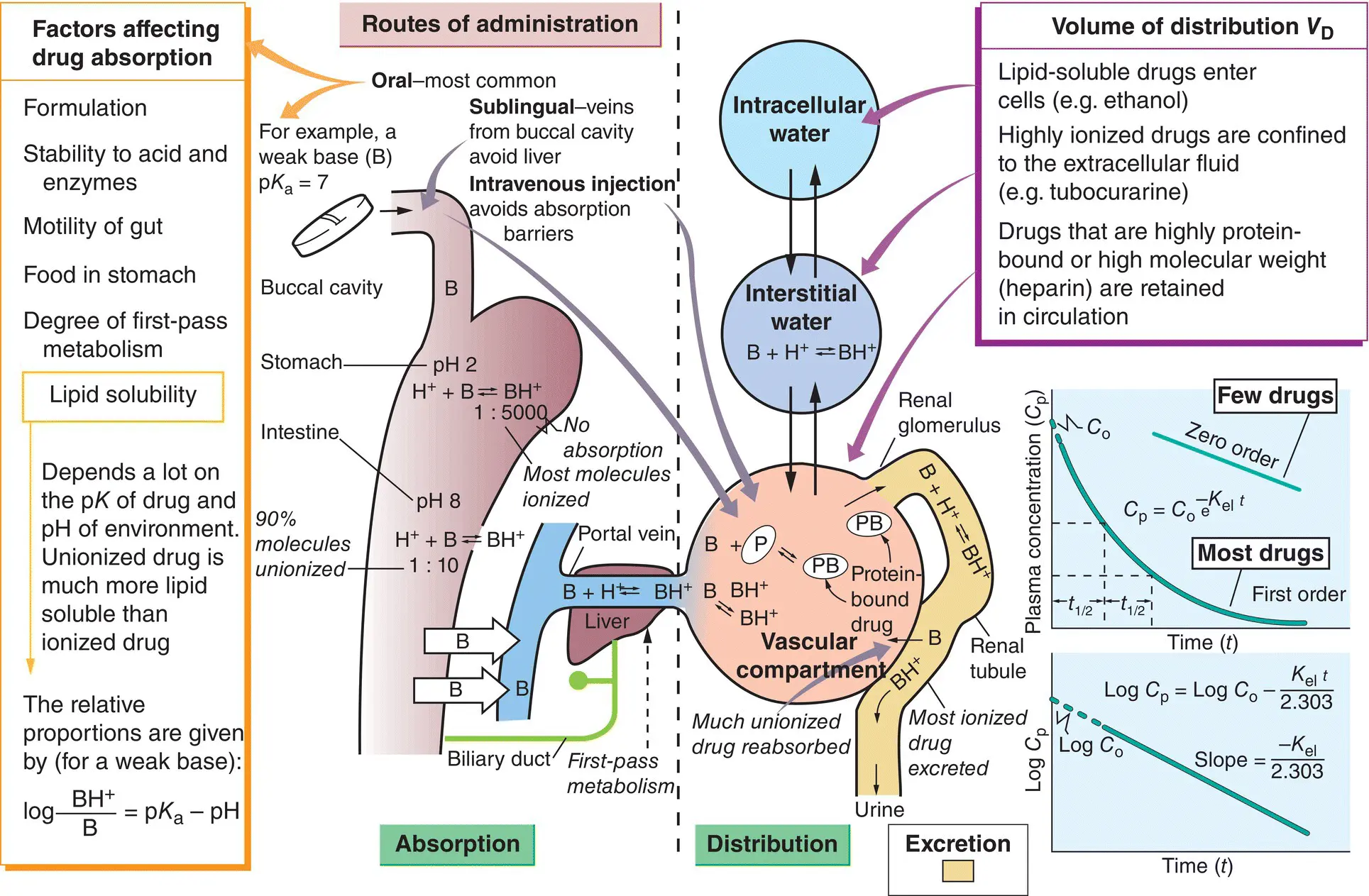
Most drugs are given orallyand they must pass through the gut wall to enter the bloodstream (left of the figure,  ). This absorptionprocess is affected by many factors (left), but is usually proportional to the lipid solubilityof the drug. Thus, the absorption of non‐ionized molecules (B) is favoured because the latter are far more lipid soluble than ionized molecules (BH +), which are surrounded by a ‘shell’ of water molecules. Drugs are absorbed mainly from the small intestine because of the latter's large surface area. This is true even for weak acids (e.g. aspirin), which are non‐ionized in the acid (HCl) of the stomach. Drugs absorbed from the gastrointestinal tract enter the portal circulation (left,
). This absorptionprocess is affected by many factors (left), but is usually proportional to the lipid solubilityof the drug. Thus, the absorption of non‐ionized molecules (B) is favoured because the latter are far more lipid soluble than ionized molecules (BH +), which are surrounded by a ‘shell’ of water molecules. Drugs are absorbed mainly from the small intestine because of the latter's large surface area. This is true even for weak acids (e.g. aspirin), which are non‐ionized in the acid (HCl) of the stomach. Drugs absorbed from the gastrointestinal tract enter the portal circulation (left,  ) and some are extensively metabolized as they pass through the liver (first‐pass metabolism).
) and some are extensively metabolized as they pass through the liver (first‐pass metabolism).
Читать дальше
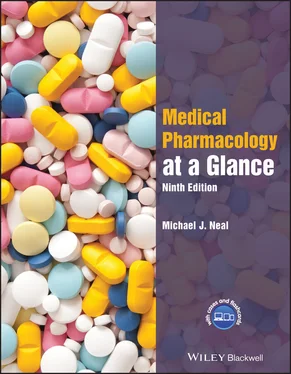

 ). This absorptionprocess is affected by many factors (left), but is usually proportional to the lipid solubilityof the drug. Thus, the absorption of non‐ionized molecules (B) is favoured because the latter are far more lipid soluble than ionized molecules (BH +), which are surrounded by a ‘shell’ of water molecules. Drugs are absorbed mainly from the small intestine because of the latter's large surface area. This is true even for weak acids (e.g. aspirin), which are non‐ionized in the acid (HCl) of the stomach. Drugs absorbed from the gastrointestinal tract enter the portal circulation (left,
). This absorptionprocess is affected by many factors (left), but is usually proportional to the lipid solubilityof the drug. Thus, the absorption of non‐ionized molecules (B) is favoured because the latter are far more lipid soluble than ionized molecules (BH +), which are surrounded by a ‘shell’ of water molecules. Drugs are absorbed mainly from the small intestine because of the latter's large surface area. This is true even for weak acids (e.g. aspirin), which are non‐ionized in the acid (HCl) of the stomach. Drugs absorbed from the gastrointestinal tract enter the portal circulation (left,  ) and some are extensively metabolized as they pass through the liver (first‐pass metabolism).
) and some are extensively metabolized as they pass through the liver (first‐pass metabolism).






